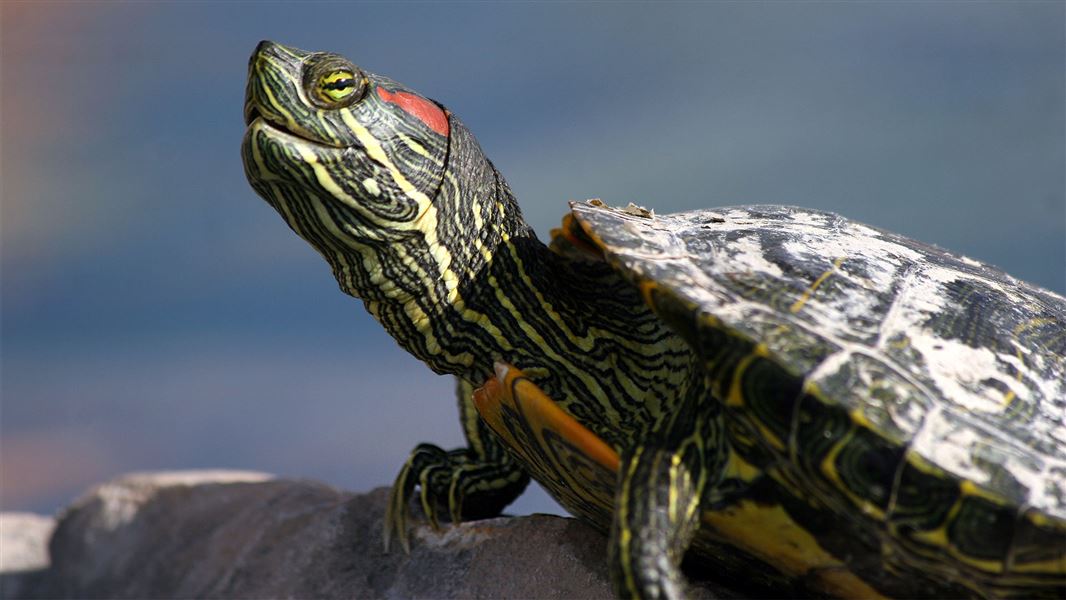Description and life history
Red-eared slider turtles (Trachemys scripta elegans) are native to North America. Pet turtles that escape or are released into the wild in Aotearoa New Zealand are considered an invasive species.
These turtles have an olive green to brown shell patterned with yellow spots or stripes. Most individuals have a distinctive red stripe behind their eyes but some may have an all-black head.
They can live for up to 50 years in captivity and grow to the size of a dinner plate (shell length 35 cm).
The ‘slider’ part of their name comes from their tendency to slide into water quickly after basking in the sun on rocks and logs.
Turtle eggs need to be kept at 22–33°C for 55–80 days to hatch into live young. Only male turtles are produced below 28°C. In warmer parts of Aotearoa, turtle eggs can hatch but do not currently produce female young.
As climate change brings increased temperatures, there is a concern that both male and female young will hatch and allow breeding populations to become established in the wild.
Turtles as pets
Turtle housing needs
To live a healthy life, red-eared sliders need a large heated indoor aquarium that holds at least 400 litres of water, along with a high-quality water filter and regulated lighting. This set-up can cost up to $3,000.
If red-eared sliders live in an outdoor pond, it must be secure. These animals are excellent climbers and have a strong desire to seek out new habitat in the spring. They can travel several kilometres overland.
See more information about turtle care and housing:
A pet for 50 years
Turtles are an expensive, demanding pet and require a big commitment, so do plenty of research before you decide to get one. Think about how you would care for it for 50 years – your turtle could outlive you.
Some owners abandon their pets when they realise what adult turtles need. Turtle rescue centres also end up with many adult turtles to try and re-home. Consider adopting an adult turtle from a rescue centre rather than buying a young one.
It is illegal to release turtles into the wild as an offence under the Biosecurity Act and the Animal Welfare Act, and in some regions would breach Regional Pest Management Plans. You could face a fine of $5,000.
What to do if you see a turtle in the wild
There are no native freshwater turtles in New Zealand so any turtle you see in the wild is an escaped exotic species.
If you see one, take a photo and record it on iNaturalist or Find-A-Pest.
This information will help us and regional councils find out how many turtles are living in our waterways and wetlands and guide work to manage them.
If the turtle looks sick, injured or in need of urgent care, contact your local SPCA or vet. If the turtle is away from the water and it is safe to do so, put it in a suitable secure container (a fish bin or chilly bin is ideal) with wet towels. Keep it at home in a cool place until advised what to do next by the SPCA or vet. Turtles can survive for weeks without eating, so you don’t need to provide food straight away.
If you see a female turtle laying eggs and it is safe to do so, put it in a secure container. Turtles can bite so handle it by the sides of the shell. Then either remove the eggs or mark the location of the nest and notify your local regional council.
What to do if you’re struggling to look after your pet turtle
If you need some help providing care for your pet turtle, contact the SPCA to find out how they could support you.
If you can’t care for your turtle anymore, try to find someone who is prepared to give it a lifetime home. You could also make contact with a turtle rescue centre to see if they can help. Search online to find rescue centres in New Zealand.
Like any pet, turtles should not be released into the wild because of the damage they can cause to our native plants and animals.
Regional management
Northland
Sightings must be reported directly to Northland Regional Council.
Auckland
Red-eared slider turtles cannot be sold, distributed, released or allowed to breed in the Auckland region. See Tiaki Tāmaki Makaurau | Conservation Auckland for more information.
Waikato
See information about red-eared slider turtles in Waikato.
Where are they found?
Distribution
This species is found throughout Aotearoa but more commonly in northern regions. Red-eared sliders enter semi-hibernation in the winter months, spending weeks at a time hidden underwater or in wet vegetation.
They emerge in the spring to find food and breed and are seen most frequently in spring and summer. In these seasons, females encountered away from water are likely to be looking for somewhere to lay their eggs.
Habitat preference
Red-eared slider turtles like to live in still or slow-moving water, such as wetlands, ponds, lakes, rivers and drainage ditches.
What harm do they cause?
In freshwater ecosystems, turtles eat fish, plants, aquatic insects, koura, and small birds including ducklings. They can displace nesting wetland birds by taking over their nest sites to bask in the sun. Their presence in a waterway can also reduce the water quality.
The IUCN Invasive Species Specialist Group includes the red-eared slider on the list of the world’s 100 worst invasive species (PDF, 600K).
